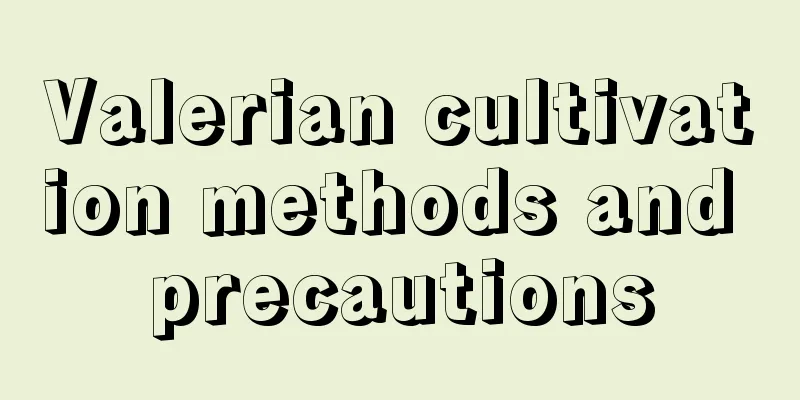Valerian cultivation methods and precautions

1. Maintenance methods1. Soil: The soil for growing valerian should be neutral sandy loam. This kind of soil is fertile and deep, which can meet the needs of growth and can grow better. 2. Water: The soil should be kept moist during the seedling stage. When the plant grows a little bigger and the soil becomes dry, water it appropriately, about once every ten days. When it rains, you can let it enjoy the baptism of rain water, just drain the water in time. 3. Nutrients: Valerian does not require much fertilizer during cultivation, and fertilizing twice a year is enough. Choose compound fertilizer and spread it evenly in the soil. Do not spread it directly on the roots of valerian to avoid burning the roots. 4. Light: Valerian does not like strong light and should be placed in diffuse light. This will allow it to better absorb light and promote vigorous growth. 2. Breeding techniques1. Pruning: During the maintenance period, regular loosening, weeding and pruning are required to better enable the valerian to grow. If there are yellow and wilted branches and leaves, they should be pruned off appropriately so that they can better absorb nutrients and grow healthily. 2. Reproduction: The main method of reproduction is seed propagation. After the seeds are mature, they are scattered in the soil. Spray water to keep it moisturized, and then it will sprout in about half a month. 3. Problem diagnosis and treatment1. Mosaic disease: Mosaic disease is common during the growth period of valerian, and this disease will directly affect the growth of the plant. The solution is to prune off the diseased branches and leaves and then spray them with antiviral regulators. 2. Mole cricket: Mole cricket is a common pest of valerian. It is very harmful to valerian. If it is not killed in time, it will affect its growth. It can be solved by spraying it with diluted dichlorodiphenyltrichloroethane. IV. Other issues1. How to spend the winter: In winter, it should be moved indoors for maintenance, and the room temperature should be controlled at around 20 to 24 degrees Celsius, and then placed in a place with sufficient light and good ventilation, so as to ensure its safety during the winter. 2. Whether it can be exposed to rain: Valerian can be exposed to rain. The humid air in rainy weather can provide moisture to its branches and leaves, and can also wash away the dust on its branches and leaves, making it look brand new and extraordinarily beautiful. |
<<: Breeding methods and precautions for small blue clothes
>>: The cultivation method and precautions of Xiebai
Recommend
Diseases and Pests of Rieger Begonia and Their Control
Diseases and their control of Rieger Begonia Leaf...
How to cultivate Xianrenshan
Xianrenshan Growing Conditions Xianrenshan is a s...
What is the best fertilizer for carambola?
Fertilization time for carambola The base fertili...
When is the best time to sow Thousand Bird Grass
Planting time of plover Plover is an annual herb ...
How to grow chrysanthemum well
1. Maintenance methods 1. Temperature: Chrysanthe...
What kind of soil does agave like? Does it like sunlight?
1. What kind of soil do you like? Its origin is i...
Where is taro suitable for growing? What kind of environment does it prefer?
Where does taro grow? Taro is suitable for growin...
What to do if the core of the cymbidium orchid leaves turn yellow
1. Yellowing caused by poor lighting Cymbidium is...
How to plant and manage Allium macrocarpon
1. Planting method 1. Planting time: Allium gigan...
I went back to my hometown during the Chinese New Year and didn’t water the flowers for a month, but they grew wildly!
Infusion tube watering method Steps: 1. Find a pa...
How to grow tulips in water? How long can hydroponic tulips live?
1. Prepare the container To grow tulips in water,...
The correct way to water the copper coin grass, what kind of water should be used to water the copper coin grass
1. Watering time The pennywort needs to be watere...
How to repot a money tree
1. When do you need to change the pot? Repotting ...
How to grow the maidenhair fern more vigorously?
The maidenhair fern , also known as wire grass, h...
How to make Yacon sprout quickly
Yacon germination environment After the yacon is ...









